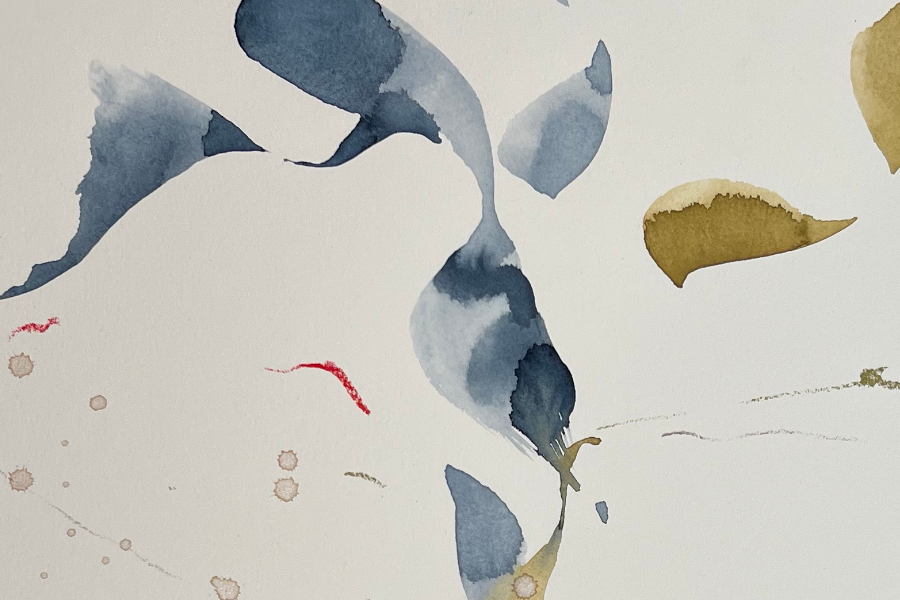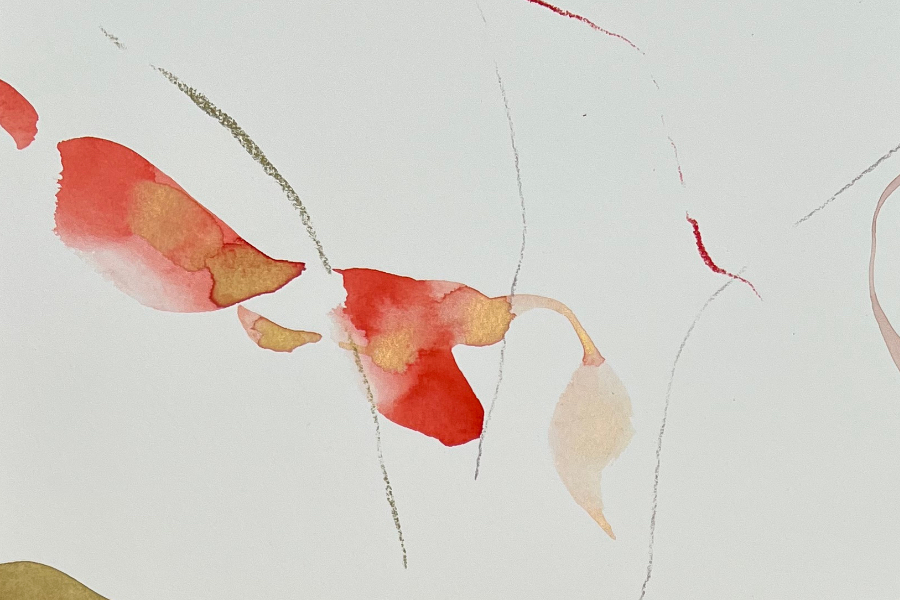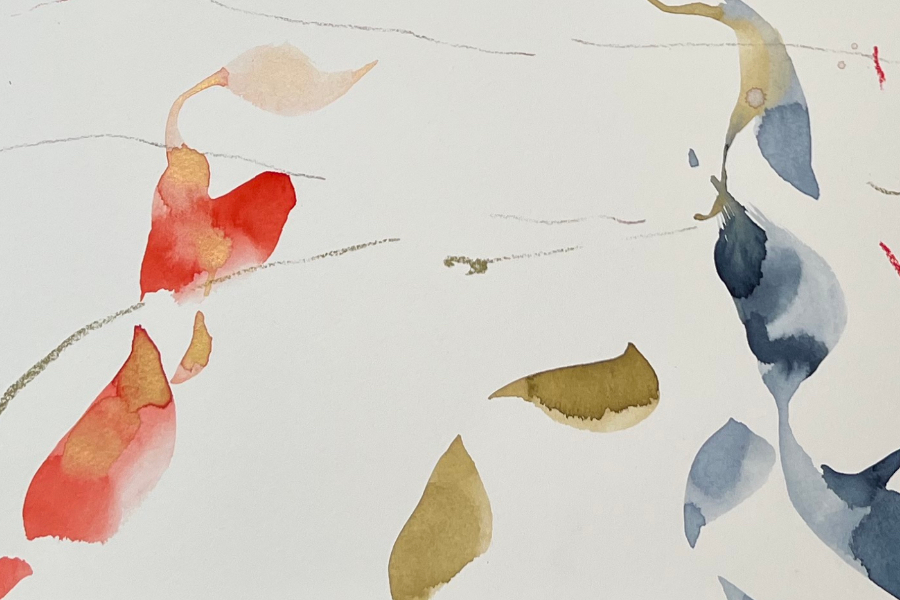Each wave, larger than the one before.

This piece is part of the 随筆 | Zuihitsu notebook, which features original art by Satsuki Shibuya.
“There is geological evidence that large tsunami have occurred thousands of years ago. The earliest description of tsunami-type waves comes from the northern part of the Aegean Sea. In terms of the earliest tsunami in the historical record, a volcano erupted on Santorini Island, Greece, and created a large tsunami. The years I’ve found for this event are 1628 BC and 1410 BC. This tsunami is thought to have been so large that it destroyed an entire civilization . . . .” (Authority: Dr. Hal Mofjeld, interview on February 25, 2005, NOAA Center for Tsunami Research.)
My grandparents came from Japan in the early 1900s—the maternal side from Hiroshima, the paternal from Kumamoto. Family facts: my maternal grandmother was a picture bride and married my grandfather right on the dock, immediately after she landed in Hilo, Hawaiʻi. My grandparents both worked in the cane fields as contract laborers. Later, my grandmother taught at a Japanese Language School.
My paternal grandmother ran away from her abusive husband and came to Hawaiʻi with her brother who acted as her husband so she could leave Japan. Like most immigrant women, she worked as a field hand. Later, she married my grandfather who had also come from Kumamoto.
We are from Hiroshima, the “Broad Land” on one side
We are from Kumamoto, the “Bear Clan” on the other
We had come from the Ring of Fire and Water
My great-grandparents had secrets
There’s nothing for us to know
My mother said our family’s lives began here
There’s no need to bring up the past
Learn about children who had drowned
or had fallen down steps or out of trees
This is what I heard between the walls: Long ago, the family, unable to feed their children, sold one of their daughters as a concubine to a daimyo. She became a favorite of his. He gave her his name and mon, but stripped the mon of its wisteria. We inherited the leaves.
March 11, 2011: Japan suffered a huge earthquake and tsunami that killed thousands of people, leaving a devastation that was unimaginable. It was a day we were riveted to the television, watching the tsunami happening before our eyes. How dark the water and how swiftly it came in. I watched as many people in their cars were washed away. I do recall a couple of stunning facts about the event that still seem incredulous in my mind: that the tsunami was because of a 9.1 quake, one of the largest in the world, and that it had lasted only six minutes but had generated, according to Wikipedia, “powerful tsunami waves that may have reached heights of up to 40.5 meters (133 ft).” I also learned these facts: “The 9.1 earthquake moved Honshu . . . 2.4 m (8 ft.) east, shifted the Earth on its axis . . . between 10 cm (4 in) and 25 cm (10 in.), increased earth’s rotational speed by 1.8 µs per day.”
birds rise from the coast
water recedes and ascends
a surging death wall
A couple of days before Good Friday, March, 1964, I flew from Honolulu to visit my parents in Hilo. On Good Friday, the tsunami sirens sounded and we packed up and went up to Hālaʻi Hill to watch the water—to see if it caused a wave. It would take a few hours before people who lived in the inundation areas could go back home, the civil defense announced on the radio. We didn’t live in any of those areas, but my parents weren’t taking any chances. We fell asleep in the car. Next morning, the news on the radio said that the Big Island sustained some damage but no one was injured. Some shoreline roads had to be cleared, and a few houses were damaged. The earthquake that generated the tsunami in Alaska was the largest ever in North America.
After the roads were cleared, my father wanted to see the damage done by the tsunami. “Come on, let’s go take a ride and look at what happened.” I frankly didn’t care to go. I didn’t want to smell the dead fish and see the salt-wilted sea grass along the shoreline. “A waste of time if you ask me!” I said. Looking at my father, I knew he was miffed that I didn’t care to accompany him.
I live in a Ring of Fire
I was a child of my father’s fire
At times his ire
At the Hukilau Hotel near Reed’s Bay, three colored lines on the entrance wall marked the height of the waves that came in on Good Friday. “Pretty high, yeah? A ten-foot wave!” he said. I nodded and smiled, trying to appease him.
May 23, 1960: “A 9.5 earthquake—the largest ever recorded—hit southwest Chile, generating a tsunami that struck the Hawaiʻian Islands in about 15 hours. The Hilo Bay area on the island of Hawaiʻi was hit hard by a 35-foot wave, which destroyed or damaged more than 500 homes and businesses. Sixty-one people died, and damage was estimated at $75 million. Where wave heights were in the 3-17 foot range, the tsunami caused little damage elsewhere in the islands . . . .” (CBS News)
My mother paced the porch like a tiger.
A classmate drowned that night. We had gone to the Junior Prom the week before, where the record, Put Your Head on My Shoulder, played on and on . . . .
We shook hands when he brought me home.
1959: I could not seem to find any references to tsunami alerts at this time. I do remember, however, having heard several alarms being activated.
Early one morning, when my sister and I were dressing for school, the tsunami sirens began. Neither my sister nor I were worried, and one of us automatically went to turn on the radio for further information. Only my mother had on her “worry” face. She rushed to her bedroom and retrieved what she called her daijina box filled with important papers, money, her wedding ring, and other valuables, and clutched it under her arm. “Hurry,” she said and drove us up Hālaʻi Hill to watch Hilo Bay below.
We hung around the car or walked over to talk with classmates there. We waited for the all clear.
April 1, 1946, April Fools Day: “An 8.1 magnitude earthquake off the Unimak Island of the Aleutian Islands, generated a huge tsunami. Waves traveled across the ocean at 500 miles an hour and measured 55 feet high, crest to trough . . . . The wave reached Hilo, Hawaiʻi 4.9 hours later.” (USGS)
A tsunami washed into Hilo Bay and engulfed Shinmachi on the shoreline, the highest waves taller than coconut trees.
I live in the Ring of Water
I was the child of my motherʻs water
I was the child of her sorrow
My mother’s story: The cottage we lived in exploded behind us with the first wave. Running from the water I could only imagine what was happening—the shattered lumber of our home spiraling into the air, large splinters falling into the water with what was left of the house, spinning away. Your father started the car. Bachan called out, “Leave me. You young ones, save yourselves.”
Each wave, larger than the one before. I lost sight of your father and all sense of time. Waves came at us like gigantic fists that hit and wrapped us in a blanket of black volcanic sand that pressed us down toward the dark ocean floor. It was cold and quiet as we sank, your arms choking me.
I wanted to scream but couldn’t; water filled my mouth each time I opened it. I needed air, but about to drown, I gulped the sandy, salty water. Looking up, I saw faint images, as in a dream—bobbing doors and bodies, paddling dogs, overturned cars—tumbling, in spinning passes.
Murky ghost shadows. Far off, the sky and lights were where we should have been.
An undercurrent whooshed from beneath us, like a strong gust of wind that had lifted a struggling kite and pulled it upward to the sky. Its strength churned the water and drove us straight up toward the light through a thinning haze of sand and debris. My arms, legs were limp and loose as a Bunraku puppet’s.
I needed the omozukai to use his right hand to control my right hand and his left hand to control my head. Needed the ashizukai to manage my feet and legs.
I couldn’t stop trembling. I was losing my mind. The wave’s power had shredded my kimono, stripped off my bag, swept your father out to sea.
You, out of my arms.
I finally found enough strength to break the water’s surface littered with wood, bedding, floating bodies. Naked, dazed, I gasped air, painful in my body’s need, perhaps, as when a baby breaks through its amniotic fluid and is born, its first breath, surprising as this.
In the mornings after, the split dotted-Swiss curtains in the rental we lived in, floated above me like butterfly wings in the wind’s design. In, out, the sash window. One morning, I could hear calls of Japanese white-eyed birds, someone mowing. I looked out the window and saw my mother washing an old kimono with sleeves like leaves. She was crying. I wondered what had happened.
His name was Duggan. Whenever he saw me, he would say, “So you’re the little girl I saved!” I was afraid of this man called Duggan. What did it mean to be saved?
Bedtime. My mother chanted, and called the Buddha’s name in gratitude for the Inconceivable Light and Life. There were no hugs or kisses, just a tug-to-chin of my blanket with a soft shhh, close your eyes.
How the dotted-Swiss curtains moved every morning in the breezes. How they moved like leaves in their dance. One day, I woke up and watched the curtains flying over me. I felt strange. I realized I must have continued throughout the night to be there, on my bed, watching the curtains. It wasn’t as if I had been gone when I slept. When I got up, I had been there all along. My life continued—from day to night to day and on and on. A new day, a new breath.
With no memory, there would have been no remembering. If I had died in the tsunami, I’d have been no different than leaves or one of Duggan’s piglets floating by out to sea.
Such is The Way.



